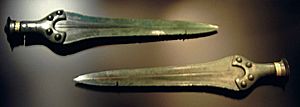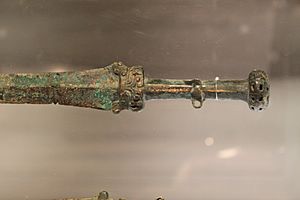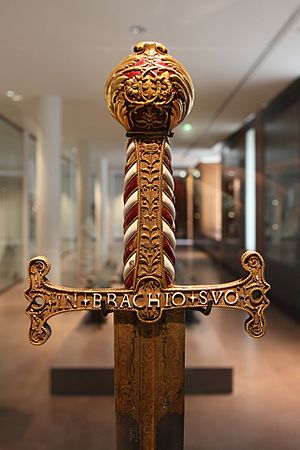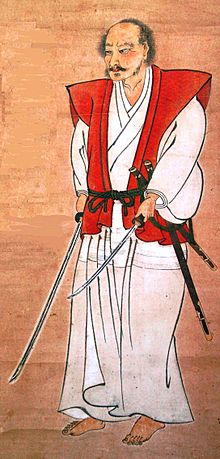Chronology of bladed weapons facts for kids

Bladed weapons are tools or weapons with a sharp edge, like swords, daggers, and knives. They have been super important throughout history! People used them for fighting and in wars. But these weapons were also special in other ways. They were part of old traditions, myths, and even burial ceremonies.
Contents
The Story of Bladed Weapons
This timeline tells the story of different bladed weapons. It includes swords, sabers, rapiers, foils, machetes, daggers, knives, and arrowheads. There are many more facts about swords, but other bladed weapons are also included.
Early Bronze Swords

The first known bronze swords were at least 60 centimeters (about 2 feet) long. They appeared around 1700 BC. These early swords were found near the Black Sea and the Aegean Sea.
For a sword to be good for fighting, it needed to be made from the right metal mix. It also needed the correct shape and special heat treatments. Longer swords faced more stress, so they needed to be strong. A good sword had to be hard enough to cut, flexible enough not to break, and durable to handle blows.
Here is how they made bronze swords:
- Bronze was melted and poured into molds.
- Then, the swords were heated to a certain temperature.
- They were allowed to cool slowly.
- Finally, they were hammered when cold. This made them even harder!
- Around 1275 BC: An Assyrian sword with special writings was made.
- Around 650 BC: Pausanias wrote that Theodore of Samos invented casting bronze objects.
From 500 BC to 500 AD

This period saw many developments in bladed weapons.
- Around 450 BC: Herodotus wrote about iron swords found in Scythian tombs. They were seen as symbols of the god Ares (Mars).
- Around 401 BC: People described Indian steel, called Wootz steel, and two swords made from it.
- 326 BC: At the Battle of the Hidaspes River, Alexander the Great defeated King Porus. Porus gave Alexander about 10 kg of "Indian steel."
- Around 230 BC: Philo of Byzantium wrote about the flexible swords of the Celts and Iberians in Hispania (modern Spain). Their swords could bend like a spring, suggesting they had some tempered steel.
- 216 BC: At the Battle of Cannae, Polybius described Iberian swords as good for both cutting and thrusting. Gaulish swords were good for cutting.
- 197 BC: The Gauls were defeated by the Romans. The Gaulish swords would bend after the first hit and had to be straightened. The Romans used this weakness to win.
- Around 20 BC: Diodorus Siculus, a Greek historian, wrote about the excellent cutting quality of Celtiberian swords and how they were made.
- Around 5 BC: The poet Gratio Falisco mentioned the famous knives of Toledo, Spain.
- Around 50 AD: Pliny the Elder discussed different types of iron. He also wrote about how important water was for tempering steel.
- Around 90 AD: The poet Martial, from Bilbilis (near Calatayud, Spain), was proud of his country's steel. He said it was better than the steel from Gaul or Noricum.
The Middle Ages
The Middle Ages brought new sword designs and legends.
- Around 500 AD: A shipwreck near Nydam, Denmark, held swords made with a "pattern-welded" technique.
- Around 700 AD: A Japanese legend says that the sword maker Amakuni was worried about swords breaking in battle. After much work, he changed how swords were forged and tempered. He created curved swords that did not break.
- 796 AD: Emperor Charlemagne gave King Offa of Mercia a sword made by the Huns. It was taken as war loot.
- 802 AD: Harun al-Rashid owned a very high-quality sword called Samsam. When the Byzantine Emperor sent him some Byzantine swords, Harun easily broke them all with his Samsam sword.
- Around 850 AD: Abu Yusuf al-Kindi described the famous swords of Damascus.
- Around 900 AD: The first written records of the katana appeared. Master Yasu-tsuna from Hoki was a famous maker.
- 966 AD: Borrell II's embassy gave 100 "frank swords" as a gift. These swords were very famous and feared.
- 1146 AD: The earliest clear mentions of the naginata, a Japanese pole weapon, appeared.
- 1233 AD: Jaume I mentioned his sword called "Tiso," made in Monzón, during the siege of Burriana.
- 1248 AD: The sword Lobera belonged to King Fernando III of Castile.
- 1274 AD: The Sword of Vilardell belonged to the knight Soler de Vilardell. It was thought to be magical and had amazing cutting quality.
- 1370 AD: In his will, Pere el Cerimoniós mentioned the sword of Sant Martí and the sword of Vilardell.
- 1392 AD: Ibn Hudhayl wrote about two types of high-quality swords: those from Indian steel and those from the Franks (Catalan). The Frankish swords were thought to be so good they were forged by geniuses.
- 1425 AD: Sword makers in Valencia asked for their rules to be confirmed. These rules were copied from the sword makers of Barcelona.
- To become a master sword maker, applicants had to present four sword blades and their decorations. This included a two-handed sword, a one-handed sword, another one-handed sword, and a plain white sword.
- 1433 AD: In Barcelona, the "Book of the councils" for sword makers described how to temper sword blades.
- The book also mentioned "confrare ho confraressa," meaning a woman could belong to the guild of sword makers. This might have been as a wife or widow of a sword maker.
From 1450 to 1700
This period saw famous swords and new ideas about their making.
- 1474 AD: Jaume Ponç, a fencing teacher from Majorca, wrote a book about fencing.
- 1478 AD: Julián del Rey was a famous sword maker known for swords with a "perrillo" (little dog) mark. He was likely a former Muslim armor maker who became Christian. He worked in Zaragoza and Toledo.
- 1509 AD: Swords from Zaragoza were given to Henry VIII of England when he married Catalina of Aragon.
- 1517 AD: Swords proved to be very effective weapons for the Spanish conquistadors against Native Americans in Florida.
- 1522 AD: Ignacio de Loyola offered his sword to the Virgin of Montserrat.
- 1525 AD: At the Battle of Pavia, Francis I of France gave his sword to Joan Aldana, a knight from Tortosa.
- 1540 AD: "Pirotechnia" by Vannoccio Biringuccio discussed iron mines and how to reduce metal in a forge.
- Around 1541 AD: Francisco Pizarro's sword was made in Valencia by Mateo Duarte.
- 1544 AD: Henry VIII of England had a hunting saber decorated by Diego Çaias.
- 1546 AD: Georgius Agricola wrote about mineralogy. He mentioned that Noricum (now Steyr, Austria) produced high-quality steel. Other places like Bilbao and Como made steel due to the quality of their water.
- 1547 AD: The "de San Martí" sword was mentioned again (see 1370 AD).
- 1547 AD: A law was passed setting the maximum length for sword blades in Mallorca, Valencia, and Catalonia.
- 1599 AD: Pope Clement VIII gave a sword from Solingen to King Henry IV of France.
- 1611 AD: The oldest definition of a cinquedita appeared. It was described as a small weapon, only five fingers long, used in Venice.
From 1700 to 1950
This period saw the rise of factories and new sword designs.
- 1742 AD: A French dictionary described "lame de ettofe," which were sword blades with an iron core and a steel exterior.
- 1750 AD: News spread about "varnished iron" mines in Mondragón.
- 1760 AD: King Carlos III of Spain asked for a report on bladed weapon factories. He wanted to set up a new factory in Toledo.
- 1761 AD: The "Bladed Weapons Factory of Toledo" was created by King Carlos III. It was run by the Valencian sword master Lluis Calisto.
- 1766 AD: The Esquilache Riots occurred.
- 1772 AD: Henry Nock, a gun-making company founder, left his business to James Wilkinson. Wilkinson became famous for making swords and sabers.
- 1772 AD: Rules for Californian presidios (forts) described the broad sword and lance used by soldiers.
- 1781–1782 AD: For the Santa Barbara Presidio in California, Toledo swords were rejected. German, Valencian, or Barcelona swords were preferred for military use. Toledo swords were said to break easily if used carelessly.
- 1782 AD: William Bowles wrote about the making of swords in Spain.
- 1793–1795 AD: During the War of the Pyrenees, weapon workshops in Catalonia reopened.
- 1798 AD: Ignacio Jordán de Assó wrote about the sword makers of Zaragoza.
- 1804 AD: James Wilkinson continued his work.
- 1844 AD: Henry Wilkinson continued the family business.
- 1849 AD: The "Barcelona General Guide" described the guild of sword makers' sword. It was 60 inches long and needed a strong man to carry it in parades.
- 1851 AD: A Toledo sword (by Manuel de Ysasi) was shown at the Great Exhibition in London. It could be taken out of its sheath and put back in a nearly circular sheath.
- 1856 AD: Details about how swords were made at the Toledo Factory were published.
- 1865 AD: Henry George O'Shea listed swords in the Royal Palace of Madrid's armory.
- 1943 AD: The famous Sword of Stalingrad was made.
See also
 In Spanish: Historia de la espada para niños
In Spanish: Historia de la espada para niños




